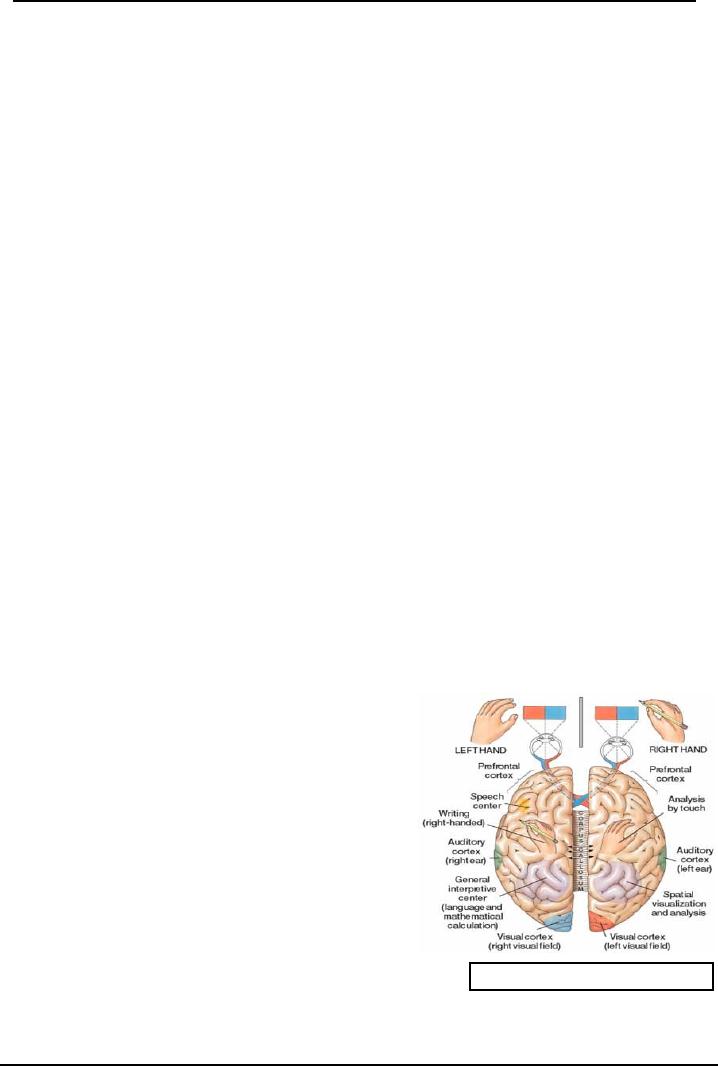 |
INTRODUCTION:Descriptive, Experimental and/ or Natural Studies |
| BRIEF HISTORICAL REVIEW:Roots of Behavioural Neurosciences >> |

Neurological
Basis of Behavior (PSY -
610)
VU
Lesson
01
INTRODUCTION
Objectives:
�
To
familiarize the students with
study of brain behavior
study.
�
To
orient them towards its historical and
scientific roots.
�
To
relate it to other areas of
specialization in Psychology.
Introduction
The
mastermind of all our living
being is the brain which
controls every aspect of
behavior from molar
to
molecular--a universe within the
small cranium. Millions of
neurons and glial cells interaction,
firing
constantly
resulting in the gross behaviors we
see or experience.
Pinel
(2002) defines Biopsychology (also
known as psychobiology, behavioral
biology, behavioural
neurosciences)
as the scientific study of biology of
behavior.
Carlson
(2005) calls it the physiology of
behavior where the brain and
physiological correlates and
modulators
of behavior are the domain of
study.
We
put together a definition
encompassing these and
simply state that "Behavioural
Neurosciences
aims
to study brain-behavior relationships
utilizing all its
specializations and
methodologies"
Basic
questions in the study of
brain and
behavior
There
are several basic questions in the study
of brain and behavior which
are part of a continuing
and
recurrent
discussion,
�
Is
brain's relationship with
behavior controlled by nature or nurture,
is it genes or environment?
�
Where
did the study of the brain
start (and who are the
major contributors, how far
do we go)?
�
How
does the brain know what to
process, where and what about
(people, places, objects)?
�
How
does the brain grow
(evolutionary and developmental
perspective)?
�
What
and where are the controls of our
motivated behaviors?
�
Why
do we remember (smells, visuals,
kinesthetic) and how do we retrieve
these memories? Why
do
we forget, what can go wrong
(Alzheimer's)?
�
Where
does pleasure, pain,
happiness addiction happen in the
brain?
�
What
are neurochemicals, what are
the various electrical,
electro-physiological, neurochemical,
biochemical,
and other changes that
take place in the brain, which molecules
go where and do
what?
�
What
happens if the systems malfunction,
does one affect the rest, or
things go on as before?
�
What
happens after brain damage-
do we reconstruct?
�
Why
is it important for psychologists to know
about the brain?
These
are the questions which make
the study of brain so
exciting, and many questions are
answered,
which
raise more questions! Research is ongoing
throughout the 24 hours somewhere
around the world.
Neuroscientists
are working around the clock
and discoveries are being made,
explanations offered
theories
formed or rejected.
There
are many ways of looking at the
brain behavior
interactions:
1

Neurological
Basis of Behavior (PSY -
610)
VU
�
Descriptive:
To
study behavior and brain
functioning as it occurs without
interfering in the
ongoing
processes. This gives one a perspective
of how behavior would occur
under natural
circumstances.
�
Comparative,
evolutionary perspective: This is
used to see when researchers
are looking for
continuity
among species as well as why and
how changes in brain and
behaviors have evolved
and
what do they lead to.
Further this also answers
many questions raised about
behaviors
which
can be partially answered by
studying animals. Are evolutionary
changes ongoing
processes?
Also if there are any
species specific behaviors
which are found in other
species and
the
homosapien (human).
�
Developmental
(over life span). How
does the brain grow from the
time of fertilization to
maturity,
aging and death? What are
various developmental stages?
The question keeps
arising
over
and over again whether nature or
nurture triggers or controls
it, whether it is biological
and
genetic
programming or external stimulation
which moves development in a
particular
direction.
Where can things go wrong or where
does the environment and nature interact.
How
many
degrees of freedom for
either to act and when?
Experimental
and/ or Natural
Studies
The
continuum of research and investigation
extends from the naturalistic
ethological studies i.e.
from
Joan
Goodalls chimpanzee studies and
Konrad Lorenz's earlier
investigation to experimental/
laboratory
studies
to brain manipulation
studies.
Molar
and molecular
The
level of studies on analysis within the
brain varies from studying
behavior of a large number of
neurons
or just one under the microscope. The
Molar view focuses on groups of
networks, neurons or
neuroantomical
areas whereas the Molecular
investigation focuses on single
units, single cell,
single
molecule,
single impulse and the brain
behavior relationships.
In
addition to the above there are many
areas which form part of
neuroscientific study
i.e.
neurohormonal
influences on growth, development and
subsequent expression and modulation
of
behavior,
the role of sleep, dreams and
how the brain controls these
are also important in
understanding
brain
behavior relationships. Behavioral
neurosciences studies the brain-behavior
relationship from a
wide
range of perspectives and specializations.
Range
of Behaviors:
Areas
in brain/behavior relationships which
have been
studied
and researched range from simpler to
complex
behaviors,
as they form part of human and
animal
behavioral
repertoire.
Some
of the simpler behaviors (as
they can be measured
as
activity
is ongoing and the neurochemical
interactions,
neuroantomical
substrates are fairly well
identified) are
feeding,
thirst, sexual behavior, temperature
regulation
aggression
etc.
Similarly,
neuroantomical
and
neurochemical
substrates of vision, perception,
audition,
movement
of body parts are also
fairly well defined
by
research
carried out so far.
However,
complex behaviors are of special
interest. We are
Fig.1.1
Cerebral
Hemispheres
intrigued
by the brain mechanisms of memory,
learning and
forgetting
(why do we have different types of
learning and /or memories), attachment,
addiction,
emotional
states (anger, fear)
etc.
2

Neurological
Basis of Behavior (PSY -
610)
VU
There
are even more complex behaviors
such as brain hemispheric functioning of
the cerebral cortex
and
these become more interesting as
new technologies such as MRI
emerge which pose challenges
to
scientists.
Further more, Depression, Schizophrenia are
far more complex and are
not easily
investigated.
Neurosciences:
The
most interesting area has
grown rapidly in the last century.
The 21st century is the
century of the
brain.
In the middle of the 1970's a brain
scientist, Valenstein wrote a book
"Brain
Control" predicting
possibilities
emanating from the study of the brain.
Researchers investigate how
behavior is related to
neuroanatomical
localizations, neurochemicals and how
behavior can be controlled
with the
manipulations
of these as well as drugs and
external "controls".
The
most interesting aspect of
this area is the intricacy
and interdependence of
brain-behavior
relationship
and connections. It is most fascinating to
discover how the brain
masterminds behaviors of
organisms.
This is the Pandora's Box, the more we
know the more questions emerge and the more
we
realize
we don't know enough, i.e.
the less we know. Researchers and
fields have multiplied
incredibly
from
the 60's in the last century and research
is ongoing 24 hours of the day
around the clock in
labs
around
the globe. So much so that
Behavioural Neurosciences has
emerged as a discipline where
boundaries
between chemistry, biochemistry,
ethology, physiology, neuroanatomy,
pharmacology,
psychology,
neurobiology and even neurophysics have melted and
merged into one discipline
while
spawning
others.
Issues
in Neurosciences:
This
discipline has many issues,
some of which we have discussed
earlier, however, we must
remember
it
is not easy to study the
brain, and there are many
views of how the brain
functions. We can
generally
categorize
viewpoints regarding the brain
functioning as follows:
1.
Localization
vs. Equipotentiality:
Among
the major issues investigated in
Behavioural Neurosciences is the
localization of functions. Is it
one
area or a group of areas
working together (you need
to see or feel or estimate
distances when
walking),
how do they "talk to each
other and who listens to whom".
Are functions and
neuroanatomical
areas
localized (specialized) or equipotential
(all areas have similar
capabilities) or is it a combination
of
both.
2.
Nature
vs. Nurture:
The
eternal nature-nurture debate continues
in this discipline, i.e.
whether the behaviors such
as
Schizophrenia
have a genetic, biochemical basis or
are the behaviors environmentally
influenced.
Related
to this is the major issue of
development of the brain. Does the
brain during
development,
accept
environmental influences or is it preprogrammed to
develop in a predetermined manner.
Findings
have shown that both nature
and nurture play a very
important role in the
development.
At
present the Behavioural Neuroscientists
are wiser and do not take up
such controversial
either/or
positions
It appears that genes or
environment do not act
alone, so nature provides the template
on
which
the environment can act.
Behaviors are not categorized
simplistically as one or the other;
they are
resultants
of complex interactions of both.
Research in future may be
able to pinpoint exactly how
much
each
contributes to the development of
behaviors. Till
such time it would be
appropriate to
remember
that both have important
roles to play in the
appearance, development, growth
and
expression
of behaviors.
3)
Molar level vs. Molecular
level:
The
scope of behaviors studied in
the neurosciences vary from
microscopic to holistic levels,
Micro-(reductionism
as it reduces behavior to its
cellular component) to
macro ( holistic
and more as a
total
than sub components). The
behaviours studied under the micro
level could be that of a
cell, or
components
within a cell, its
electrophysiological functioning, its
ionic movements etc. Whereas
macro
3

Neurological
Basis of Behavior (PSY -
610)
VU
could
be a group of cells, or neurochemical pathways or
behaviors emanating out of
neuroanatomical
location
or even behaviours of a species.
Behavioural
neuroscientists now use both
methods in combination (Can do observations in
lab using
open
field technique and experimental
methods in open ranging animals
implant electrodes to
study
natural
behavior).
Behavioural
Neurosciences thus is as
wide as the fields within the
scope of its domain and
every single
aspect
of brain/behaviour relationship of any
organisms comes under its
preview. This has
extended
more
recently to a point where disciplines
such as neurophysics have emerged, and
mathematical
modeling
of neural connectivity and communication
as well as computer simulation of
complex
experiences
(and neural networks) is
very much part of
robotics.
Historical
Roots of Brain Sciences:
�
Hippocrates
stated
that the brain was the
seat and center of sensation,
thought, emotions and
judgment.
�
Muslim
contribution is the first
recorded brain dissection with anatomical
details were given by
Muslim
scientists. This is experimental as
well as descriptive (not
speculative work).
While
dissecting,
they discovered the hard protective
covering protecting the brain and
named it as Umm
ul
Dafah (hard protective
covering) and the inner covering
also the fragile mother.
These were
translated
verbatim into Latin during
the renaissance as Dura Mater
and Pia Mater (Mater
from
Umm
mother, protective
covering).
�
Franz
Gall presented
the concept of phrenology where faculties
were located in centers of the
brain.
The bumps on the cranium were
also part of his formal
theory. However, he also
presented
the
concept that the two
hemispheres were joined by corpus
callosum.
�
Around
1800's, Flourens
was
the first one to experiment with
ablation of avian brains. He
demonstrated
loss of function with
damage. He proposed the concept of
equipotentiality of the
brain
on the basis of his
investigations.
�
In
1861, Paul
Broca presented
evidence for speech expression in
specific brain areas, i.e.
frontal
motor
areas for speech. This
area is formally known as the
Broca's area now.
�
In1868,
Hughlins Jackson
presented
the idea of differentiation of two types
of language
functions-
expressive and receptive, he also elaborated on a
particular form of epilepsy
known as
the
Jacksonian seizure.
�
In
late 1800's Wernicke's
presented
evidence for control of receptive
speech in temporal
lobe.
This
area is now known as the
Wernicke's area.
�
Many
eminent names followed up on
brain research some of those
who got Nobel prizes
are
Gazzaniga,
Sperry for
their work in the 1960's.
Lashley
and Hebb are
known as the fathers of
Behavioural
Neurosciences as we know it
today.
Roots
of Behavioural Neurosciences
Basically
the roots of experimentation in psychology
emerge from adaptation of
methods of Physics.
The
well known psychophysical
methods were developed by Weber who
experimented on relationships
of
stimulus and responses. Relating
experiences to the brain has
its origins in the work of
William
James,
Karl Lashley, Sherrington
and Pavlov. To put forward
the view that biological
functions and
experiences
are related to the brain two
names stand out, that of
Lashley
and Pavlov. If we look
at the
following
continuum we see the range of work,
areas and eminent names
under each category.
4

Neurological
Basis of Behavior (PSY -
610)
VU
Areas:
Brain-------------------
-experimentation------------------natural
study
Specialization:
Neurophysiology----------Psychophysics---------------------Ethology
Names
:Sherrington............Weber,Fechner....................Darwinian
Lashley.....................Helmholtz........................Niko
Tinbergen
James.....................Young...........................Konrad
Lorenz
Experimentalists
believe that uncontrolled
observation is nonscientific; there are
too many uncontrolled
variables
in behaviors for us to draw
any conclusions.
References:
1.
Kalat J.W (1998) Biological
Psychology Brooks/ Cole
Publishing
2.
Carlson N.R. (2005) Foundations of
Physiological Psychology Allyn and Bacon,
Boston
3.
Pinel, John P.J. (2003)
Biopsychology (5th edition) Allyn and Bacon
Singapore
4
Bloom F, Nelson and Lazerson (2001),
Behavioral Neuroscience: Brain, Mind and
Behaviors (3rd
edition)
Worth Publishers New
York
5.
Bridgeman, B (1988) The
Biology of Behaviour and Mind. John
Wiley and Sons New
York
6.
Seigel, G.J. (Ed. in chief)
Agranoff, B.W, Albers W.R.
and Molinoff, P.B. (Eds) Basic
Neurochemistry:
Molecular, Cellular and Medical
Aspects
7.
Source
of
the
image
of
cerebral
hemisphere
was
taken
from
the
site
www.cwx.prenhall.com/.../medialib/images/F02_11.jpg
5
Table of Contents:
- INTRODUCTION:Descriptive, Experimental and/ or Natural Studies
- BRIEF HISTORICAL REVIEW:Roots of Behavioural Neurosciences
- SUB-SPECIALIZATIONS WITHIN THE BEHAVIORAL NEUROSCIENCES
- RESEARCH IN BEHAVIOURAL NEUROSCIENCES:Animal Subjects, Experimental Method
- EVOLUTIONARY AND GENETIC BASIS OF BEHAVIOUR:Species specific
- EVOLUTIONARY AND GENETIC BASIS OF BEHAVIOUR:Decent With Modification
- EVOLUTIONARY AND GENETIC BASIS OF BEHAVIOUR:Stereoscopic vision
- GENES AND EXPERIENCE:Fixed Pattern, Proteins, Genotype, Phenotypic
- GENES AND EXPERIENCE:Mendelian Genetics, DNA, Sex Influenced Traits
- GENES AND EXPERIENCE:Genetic Basis of behavior, In breeding
- GENES AND EXPERIENCE:Hybrid vigor, Chromosomal Abnormalities
- GENES AND EXPERIENCE:Behavioral Characteristics, Alcoholism
- RESEARCH METHODS AND TECHNIQUES OF ASSESSMENT OF BRAIN FUNCTION
- RESEARCH METHODS AND TECHNIQUES OF ASSESSMENT OF BRAIN FUNCTION:Activating brain
- RESEARCH METHODS AND TECHNIQUES OF ASSESSMENT OF BRAIN FUNCTION:Macro electrodes
- RESEARCH METHODS AND TECHNIQUES OF ASSESSMENT OF BRAIN FUNCTION:Water Mazes.
- DEVELOPMENT OF THE NERVOUS SYSTEM:Operation Head Start
- DEVELOPMENT OF THE NERVOUS SYSTEM:Teratology studies, Aristotle
- DEVELOPMENT OF THE NERVOUS SYSTEM:Stages of development, Neurulation
- DEVELOPMENT OF THE NERVOUS SYSTEM:Cell competition, Synaptic Rearrangement
- DEVELOPMENT OF THE NERVOUS SYSTEM:The issues still remain
- DEVELOPMENT OF THE NERVOUS SYSTEM:Post natal
- DEVELOPMENT OF THE NERVOUS SYSTEM:Oxygen level
- Basic Neuroanatomy:Brain and spinal cord, Glial cells, Oligodendrocytes
- Basic Neuroanatomy:Neuron Structure, Cell Soma, Cytoplasm, Nucleolus
- Basic Neuroanatomy:Control of molecules, Electrical charges, Proximal-distal
- Basic Neuroanatomy:Telencephalon, Mesencephalon. Myelencephalon
- Basic Neuroanatomy:Tegmentum, Substantia Nigra, MID BRAIN areas
- Basic Neuroanatomy:Diencephalon, Hypothalmus, Telencephalon, Frontal Lobe
- Basic Neurochemistry:Neurochemicals, Neuromodulator, Synaptic cleft
- Basic Neurochemistry:Changes in ionic gates, The direct method, Methods of Locating NT
- Basic Neurochemistry:Major Neurotransmitters, Mesolimbic, Metabolic degradation
- Basic Neurochemistry:Norepinephrine/ Noradrenaline, NA synthesis, Noadrenergic Pathways
- Basic Neurochemistry:NA and Feeding, NE and self stimulation: ICS
- Basic Neurochemistry:5HT and Behaviors, Serotonin and sleep, Other behaviours
- Basic Neurochemistry:ACH and Behaviors, Arousal, Drinking, Sham rage and attack
- Brain and Motivational States:Homeostasis, Temperature Regulation, Ectotherms
- Brain and Motivational States:Biological Rhythms, Circadian rhythms, Hunger/Feeding
- Brain and Motivational States:Gastric factors, Lipostatic theory, Neural Control of feeding
- Brain and Motivational States:Resting metabolic state, Individual differences
- Brain and Motivational States:Sleep and Dreams, Characteristics of sleep
- Higher Order Brain functions:Brain correlates, Language, Speech Comprehension
- Higher Order Brain functions:Aphasia and Dyslexia, Aphasias related to speech
- Higher Order Brain Functions:Principle of Mass Action, Long-term memory
- Higher Order Brain Functions:Brain correlates, Handedness, Frontal lobe